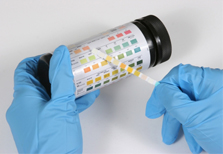Cystitis – Causes, Symptoms, Treatments
|
Reading time: 8 minutes
|

Key Takeaways
- Cystitis is the inflammation of the bladder, often from bacterial infection like E. coli or non-infectious factors.
- Symptoms can include painful urination, frequent urges to urinate, and sometimes blood in urine; can also cause pelvic discomfort.
- Types include bacterial (infections) and non-infectious (irritants, interstitial cystitis).
- Risk Factors: higher risk for women, especially after intercourse; also catheter use, certain medications, and conditions like diabetes.
- Treatments include antibiotics for bacterial cystitis; pain relief, fluid intake adjustments, and symptom management for other types.
What is Cystitis?
Cystitis is a medical term that refers to inflammation of the bladder. It’s commonly caused by a bacterial infection, particularly by Escherichia coli (E. coli) bacteria which normally reside in the colon but can enter the urinary tract through the urethra. Cystitis can also result from non-infectious causes such as irritation from certain medications, hygiene products, or conditions like interstitial cystitis.
Cystitis usually occurs when bacteria enters the urinary tract and begins to multiply. In women, a bladder infection is likely to occur after intercourse. During sexual activity, bacteria can be introduced into the bladder through the urethra.
Many cases of cystitis are caused by E.Coli bacteria that are commonly found in the genital area. Less commonly, cystitis can be caused by a reaction to drugs, radiation therapy, potential irritants like feminine hygiene spray, spermicidal lubricants, or long term use of a catheter. The usual treatment for cystitis is antibiotics.
Causes of Cystitis
- Urinary Tract Infections (UTIs): E. coli bacteria is the usual culprit, entering the urethra and traveling to the bladder, causing infection and inflammation.
- Non-infectious Cystitis: Several factors can irritate the bladder lining without involving bacteria:
- Chemical irritants: Certain beverages (coffee, alcohol, carbonated drinks), spicy foods, and acidic fruits can irritate the bladder.
- Medications: Some medications can cause bladder irritation as a side effect.
- Medical conditions: Diabetes, kidney stones, or enlarged prostate in men can contribute to cystitis.
- Catheter use: Using a catheter to empty the bladder can irritate the urethra and bladder.
- Intercourse: Friction during sexual intercourse can irritate the urethra, leading to symptoms similar to cystitis.
Symptoms of Cystitis
Cystitis, though commonly caused by a bacterial infection, can present with a range of symptoms regardless of the cause. Painful urination (dysuria) is a hallmark symptom, characterized by a burning or stinging sensation when you urinate. You might feel the need to urinate often, even after passing a small amount. A sudden, strong urge to urinate can occur, even if you just emptied your bladder.
Another common complaint reported is feeling like you haven’t completely emptied your bladder after urination. Blood in the urine (hematuria) might be visible in the urine in some cases, although it is not always present. A dull ache or pressure in the lower abdomen or pelvis can accompany the urinary symptoms. These are often accompanied by changes in urine appearance; urine may appear cloudy, or smell can sometimes occur.
Types of Cystitis
There are several types of cystitis, classified based on the cause of the inflammation. Bacterial Cystitis is the most common type, caused by bacteria entering the urethra and traveling to the bladder. E. coli is a frequent culprit.
Non-infectious Cystitis arises from irritants other than bacteria causing inflammation in the bladder lining. Examples include:
- Chemical Cystitis: Certain beverages (coffee, alcohol, carbonated drinks), spicy foods, and acidic fruits can irritate the bladder.
- Interstitial Cystitis (IC): A chronic condition causing bladder pain and discomfort even in the absence of infection. The exact cause is unknown, but it’s believed to involve mast cell dysfunction and inflammation in the bladder wall.
- Drug-induced Cystitis: Certain medications can cause bladder irritation as a side effect.
- Radiation Cystitis: Radiation therapy for pelvic cancers can damage healthy tissues, including the bladder, leading to inflammation.
- Foreign body Cystitis: Ongoing use of a catheter to empty the bladder can irritate the urethra and bladder, increasing infection risk.
Sometimes, underlying medical conditions like diabetes, kidney stones, or enlarged prostate in men can contribute to cystitis by affecting bladder function or urine flow.
Risk Factors of Cystitis
Women are at a higher risk of cystitis than men. This is primarily due to the shorter urethra in women, which makes it easier for bacteria to reach the bladder. Sexual intercourse can introduce bacteria into the urinary tract, increasing the risk of cystitis. This is sometimes referred to as “honeymoon cystitis.”
Women who use diaphragms for contraception may have a higher risk of cystitis. Spermicides and certain types of condoms can also contribute to irritation and increase the risk of infection.
Any condition or situation that obstructs or interferes with the normal flow of urine can increase the risk of cystitis. This includes conditions such as urinary retention, kidney stones, or an enlarged prostate in men.
Decreased estrogen levels in menopausal women can lead to changes in the urinary tract, making them more susceptible to cystitis.
Having a urinary catheter in place can increase the risk of developing a urinary tract infection, including cystitis.
Conditions or medications that weaken the immune system, such as diabetes, HIV/AIDS, or corticosteroid use, can increase the risk of cystitis.
If the bladder doesn’t empty completely, bacteria may remain in the bladder and cause an infection.
Poor hygiene practices, such as wiping from back to front after using the toilet, can increase the risk of introducing bacteria into the urinary tract.
Certain medical conditions, such as bladder prolapse, urinary tract abnormalities, or a history of recurrent urinary tract infections, can predispose individuals to cystitis.
How is Cystitis diagnosed?
Diagnosing cystitis typically involves a combination of a doctor’s evaluation of your symptoms, a physical exam, and laboratory tests.
The doctor will first discuss your medical history, including any past UTIs or relevant medical conditions. They will ask you detailed questions about your symptoms, such as the frequency and urgency of urination, presence of pain or burning, and any blood in your urine.
A physical exam may involve a pelvic exam for women to assess the pelvic organs and check for tenderness. Urinalysis is a basic test that analyzes the appearance, concentration, and content of your urine. It can detect white blood cells (indicating inflammation), red blood cells (blood in the urine), and nitrites (a byproduct of bacteria).
If a urinalysis suggests an infection, a urine culture is usually performed. A urine sample is collected in a sterile container and sent to a lab to identify any specific bacteria present and determine their susceptibility to antibiotics.
In rare cases, a cystoscopy might be used. A thin, lighted tube (cystoscope) is inserted through the urethra into the bladder to visualize the bladder lining and rule out other conditions like bladder stones or tumors. Ultrasound or X-rays may be used in uncommon situations to evaluate the kidneys and ureters for any abnormalities that could contribute to bladder issues.
Doctors can often differentiate between bacterial and non-infectious cystitis based on your symptoms and the presence of bacteria in the urine tests. However, sometimes additional tests or a cystoscopy might be needed for a definitive diagnosis, particularly for recurrent cystitis or if there’s a suspicion of interstitial cystitis (IC).
How is Cystitis treated?
Treatment for cystitis depends on the type and cause of the inflammation. For Bacterial Cystitis, antibiotics are the primary means of treatment. Doctors typically prescribe a short course (3-7 days) of antibiotics effective against common urinary tract infection bacteria like E. coli. It’s crucial to complete the entire antibiotic course, even if symptoms improve quickly, to ensure complete eradication of the bacteria and prevent recurrence.
For Non-infectious Cystitis, over-the-counter pain relievers like phenazopyridine (Pyridinium) or acetaminophen (Tylenol) can help alleviate pain and burning during urination.
Additionally, identifying and avoiding irritants in your diet (spicy foods, acidic fruits, certain beverages) can significantly improve symptoms. Drinking plenty of fluids (water) helps dilute urine and flush out irritants.
Strengthening the pelvic floor muscles through exercise can sometimes improve bladder control and reduce urinary urgency in some cases of non-infectious cystitis.
While there may be no cure for Interstitial Cystitis (IC), treatment focuses on managing symptoms and improving quality of life. This may involve a combination of medications, such as oral medications to relax the bladder wall or suppress inflammation, and bladder distention procedures where the bladder is filled with sterile fluid to stretch the bladder wall and potentially reduce pain.
What medications are most often prescribed for Cystitis?
Bacterial Cystitis:
- Antibiotics: These are the first-line treatment for bacterial cystitis. Here’s a breakdown of some commonly prescribed options:
- Nitrofurantoin (Macrobid): A first-choice antibiotic for uncomplicated cystitis, especially if you haven’t had recent antibiotic use.
- Trimethoprim/sulfamethoxazole (TMP-SMX) (Bactrim): Another frequently used antibiotic, but its use might be limited due to increasing bacterial resistance.
- Fosfomycin (Monurol): A single-dose option for uncomplicated cystitis.
- Fluoroquinolones (Ciprofloxacin): Reserved for cases where other antibiotics are ineffective or contraindicated. Due to concerns about antibiotic resistance, these are typically used as a last resort.
- Cephalosporins: Another option, though less commonly used compared to the above choices.
Non-infectious Cystitis:
- Over-the-counter pain relievers: Medications like phenazopyridine (Pyridinium) or acetaminophen (Tylenol) can help manage pain and burning during urination. It’s important to follow dosage instructions carefully and consult a doctor if you have any underlying health conditions before taking these medications.
Interstitial Cystitis (IC):
- Oral medications: There’s no one-size-fits-all approach for IC, but medications might include:
- Pentosan polysulfate sodium (Elmiron): Helps protect the bladder lining and may reduce symptoms.
- Antihistamines: Can help manage mast cell activity, which may play a role in IC symptoms.
- Tricyclic antidepressants (amitriptyline): May help manage pain and improve sleep, even if you don’t experience depression.
Information provided on this website is for general purposes only. It is not intended to take the place of advice from your practitioner







